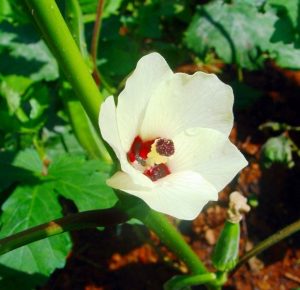Okra is grown for its long, pointed seed pods, which are used in stews, gumbos and soups. Okra is in the same family as cotton, hollyhocks and hibiscus. This edible vegetable has such a pretty hibiscus type flower it makes a nice decorative plant as well.
Okra is a tropical plant grown locally as an annual vegetable. The seed p ods are especially useful for thickening stews because of their gummy mucilage. Noted as extremely drought, heat resistant and popular where difficult growing conditions exist.
ods are especially useful for thickening stews because of their gummy mucilage. Noted as extremely drought, heat resistant and popular where difficult growing conditions exist.
Planting Okra – Okra seeds are large and easy to handle. Local gardeners like to pre-soak their seeds the night before planting. The seed can be direct sown or started indoors and transplanted into the garden. Starting seedlings in peat pots reduced transplant shock. Seed should be started indoors 6-8 weeks before being transplanted outdoor in late May.
Okra is a heat lover. Wait until the weather is reliably warm, about 2 weeks after the last frost date of May 8th. It kicks into gear when temperatures reach 80 degrees and still grows strong when it climbs into the 90s.
Direct sow seed 1″ deep and 4-8″ apart, with 3 foot row spacing. Okra plants can get 4 feet tall and 3 feet wide. When seedlings are 4-6″ tall, thin the weakest plants until remaining seedlings are at 18-24″ spacing. This will give plants room to spread. Plants closer than this result in thin plants and few fruits.
Okra does best in rich, well-draining soil. It’s not particular about soil pH of 6.5 to 7.5, but struggles in heavy, soggy soils. The more soil amendments for this crop the better.
Maintenance – If you have rich organic soils, your okra won’t need a lot of extra plant food. However, side dressing with Watters deodorized Barnyard Manure and feeding with Watters All Purpose Plant Food will give some extra fuel, and extra fruits.
Water – Once okra plants are established, they can handle brief dry spells. For best yield, water well at least twice a week.
Harvesting – Okra plants are spiny to the touch. Whether the spines are pronounced or hair-like, they are scratchy and irritating. It’s easier to harvest with garden snips or scissors, rather than pulling and getting the spines in your fingers.
Okra is best when picked young. The fruits are most tender when 2-4″ long and as wide as your pinkie. Okra can grow in the blink of an eye and usually reaches this size within 6 days of flowering. As okra pods get larger, they become stringy and tough. However if growing conditions are right during our monsoon season, even larger okra can remain tender and edible. Test for tenderness by snapping off the end of a pod. If it snaps, it hasn’t become touch and fibrous and should still be good to eat. If not, it makes a nice addition to a flower arrangement. As with most vegetables, okra is at its peak when freshly picked. Pods can be stored in the refrigerator for about 1 week or frozen, canned or pickled.
Suggested Varieties
Okra varieties labeled spineless are less irritating, but not completely spine-free.
Annie Oakley – Heavy producer, good flavor
Burgundy – Burgundy pods, but loses some color with cooking
Clemson Spineless – Good flavor, easy to pick
Emerald – Long 7-9” pods with less spines
White Velvet – Tender, white pods
 Ken Lain can be found throughout the week at Watters Garden Center, 1815 W. Iron Springs Rd in Prescott, or contacted through his web site at WattersGardenCenter.com or FB.com/WattersGardenCenter .
Ken Lain can be found throughout the week at Watters Garden Center, 1815 W. Iron Springs Rd in Prescott, or contacted through his web site at WattersGardenCenter.com or FB.com/WattersGardenCenter .

